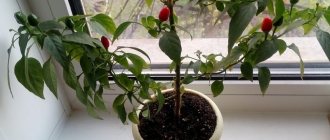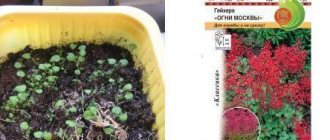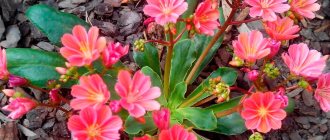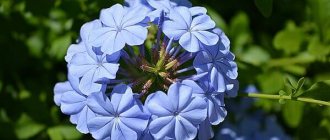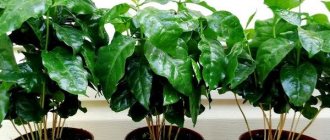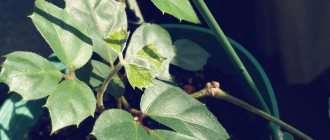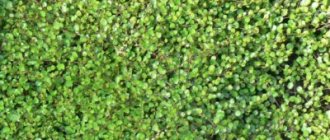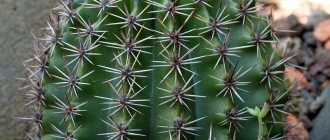Thuja is a gymnosperm conifer of the juniper family. The closest relatives of the tree, besides juniper, are sequoia and cypress. Arborvitae came to Europe from America and East Asia. The plant is considered a long-liver; under natural conditions, thujas live up to 150 years.
Gardeners grow plants in open ground and at home, for which dwarf varieties have been bred.
In this article we will look at how to care for thuja in a pot at home, namely: preparation for planting, conditions of maintenance and reproduction.
Description of thuja
Thuja belongs to the cypress family and is an evergreen coniferous tree with a characteristic aroma. Thuja is a monoecious gymnosperm plant that has male and female cones. As a result of pollination, which takes place from April to May, the seeds ripen in the form of an ovoid cone. In autumn, seeds shoot out from a ripened capsule.
Thuja grows naturally in North and Northeast America (Canada, USA). It reaches a height of five to ten meters, but is characterized by slow growth and longevity. The Indians call it “iron” tree for its durable, rot-resistant wood. Thuja, brought from the American continent, is usually called western. The pyramidal shape of the western thuja was brought to Europe in the sixteenth century. At the end of the eighteenth century, thuja began to be grown in the southern regions of Russia. It becomes part of the park landscape in Crimea and the Caucasus.
In the East, thuja orientalis is grown, which is cultivated as an ornamental and medicinal plant. In nature, it can be found on mountain slopes in China, Japan and Korea. Thuja is also called the “tree of life.” On the one hand, this name is attributed to the French king. On the other hand, this is what it is called in the East, where it is considered a cult tree. In Central Asia, it was planted in holy places, near mosques. Eastern healers use thuja to prepare medicines.
Preparing thuja seeds for sowing
The first step is to prepare and prepare the seeds for sowing. Since thuja is a frost-resistant plant, it is better to plant the seeds in the ground before winter.
Seed harvesting should be carried out in late summer and early autumn. You need to collect the cones before they open. The seeds are easy to obtain from dry buds. Place the collected seeds on the table and dry in a dry room.
It is best to sow thuja in the fall from recently collected seeds. Since the seeds will winter outside, this will contribute to the active germination of seedlings and the seeds will undergo natural stratification. If you plant seeds in the fall, the seedlings will emerge early, unlike spring sowings. Young trees do not require constant attention, grow quickly and tolerate cold well.
Types of indoor thuja
The thuja genus is divided into six main species, each of which has produced many new varieties. In indoor floriculture, two types are used: thuja occidentalis and thuja orientalis.
Western
Eastern
There are a number of differences between them that determine whether they belong to a species. It was previously believed that the western thuja has a pyramidal shape, while the eastern thuja is closer to the shape of a shrub. Nowadays, plants of different shapes have been bred in each species:
- pyramidal;
- spherical;
- dwarf and others.
Thuja globulus
Also, the color of the leaves of modern thuja can be dark green, yellowish and even bluish. Therefore, it is necessary to be able to distinguish between eastern and western thuja by the structure of branches, leaves and the shape of cones. Modern botany classifies thuja orientales, which is also called biota, to a separate genus - oriental planum.
Below is a table highlighting the similarities and differences between the Western and Eastern Arborvitae, as we will continue to call them.
| Main features | Thuja Western | Arbor vitae |
| Branches | The plant is single-trunked, and the branches are turned in different directions relative to the trunk. This gives lushness to the plant. | The branches at the base branch into several trunks growing parallel to the main trunk. The branches are raised up. |
| Escapes | The shoots are short and their ends are curved upward. | The light brown shoots are flat and form a system of plates located radially relative to the trunk. |
| Leaves | The scales on flat leaves are wedge-shaped. The needles turn brown in winter. | The leaves are round and scaly. They grow up to 1.5 cm, and are located tightly on the shoots, overlapping each other. |
| Cones | The cones are light brown in color and have an oblong shape, without “horns”. Length - about one centimeter. | The cones become red-brown and brown as they ripen. The cones have “horns”. Cones size: 1.5 cm long and about 1 cm wide. |
| Seeds | The seeds are flat-shaped with two wings, light brown in color. | The color of the flat branch seeds is brown. The size of the seeds is comparable to a grain of wheat. Their shape is oblong-round. |
This may be interesting: Formation of the appearance of Ficus Benjamin
Thuja eastern and western can be grown both in gardens, parks, and indoors, on balconies and loggias. They grow slowly and are easy to trim and form a crown. They are used for growing bonsai.
The following varieties have proven themselves well for growing indoors:
- Western Golden Globe;
- Western Teddy;
- Western Miki;
- East Aurea Nana;
- Dwarf.
Conifers in compositions and individually
Conifers in pots on the balcony and terrace look great individually or in the company of other plants. Even a small group of coniferous plants looks quite impressive. You can combine and mix different shapes - columnar, spherical and creeping. In addition to varieties with green needles, there are also silver, golden, yellow and blue-gray ones. Thanks to this variety, you can create multi-color compositions.
On a large terrace, you can create a hedge in containers from columnar thujas or junipers planted in tubs or long wooden boxes. In large tubs and wide boxes you can create a real small alpine garden on the balcony. You should choose varieties and species that grow fairly slowly, and supplement the entire composition with perennials. All it takes is imagination and desire, followed by careful care.
The choice of coniferous plants for a balcony or terrace is huge - everyone will find something for themselves. Varieties with a variety of needle colors can be combined with other conifers or perennials and small evergreen or leafy shrubs. Conifers look great in combination with seasonal flowering plants. It is worth remembering that taller specimens should be planted at the back of the pot, and with low shoots - at the front. Due to different needs for water and fertilizers, they should be planted in a separate container, and also watered and fertilized separately.
Home care rules
In order for a thuja to grow into a beautiful tree in an apartment, it is necessary to create certain conditions for it.
Lighting
Thuja, which came to us from cool places in North America, does not like hot direct rays of the sun. They cause burns on its leaves, and the needles begin to turn yellow. Thuja is considered a shade-tolerant tree. But the amount of light should be sufficient so that the branches do not stretch. The best place in the apartment is a short distance from the window, especially the south one. On northern windows you can place the pot on the windowsill.
Temperature
To create comfortable conditions for the thuja, it is necessary to provide it with the necessary temperature depending on the season. In summer, the plant feels great in a temperature range of twenty to thirty degrees. You can place a pot with a tree in your apartment, or take it out onto the balcony or into the garden.
Important! In the fresh air, the plant needs to be provided with light shade.
But in order to keep thuja in a pot in winter, you need to take care of choosing a suitable place. Thuja does not tolerate dry and hot air in apartments very well. In the cold season, the optimal temperature for the plant is no higher than fifteen degrees. If there is a glazed balcony, then the thuja is left to winter on it. It can tolerate a slight frost, but in frosty weather you need to protect the roots from hypothermia. To do this, the pot can be placed on a wooden or cardboard base, and the pot can be additionally wrapped. Also, thuja does not tolerate drafts.
Watering and humidity
Thuja tolerates dry air and soil well. Therefore, the plant does not require frequent watering, but the soil should not be allowed to dry out, especially during the growing season and after replanting. In hot weather, thuja is watered once or twice a week, depending on the air temperature. In winter, reduce the frequency and amount of water when watering. It is necessary to lightly moisten the soil once or twice a month at above-zero air temperatures. If the air temperature approaches zero in the room (on the balcony) where the pot with the plant is located, then stop watering until the temperature rises. Water for irrigation should be warm (room temperature), settled.
Important! Do not allow the soil to become waterlogged! This is harmful to thuja.
Thuja does not need additional air humidification. But in hot weather, it is recommended to periodically spray the thuja to remove dust.
This may be interesting: Yucca - home care
The soil
The soil for indoor thuja should be loose, air- and moisture-permeable. In order for indoor thuja to grow well, turn green and not get sick, it is necessary to select the soil in accordance with the age of the plant. Young plants are planted in the following soil mixture:
- coniferous soil (2 hours);
- leaf (4 hours);
- coarse river sand (1 hour).
When the plant grows up and annual replantings are no longer required, it is necessary to plant it in soil composed of peat and turf soil in equal quantities with the addition of river sand in half the dose. For an adult plant, you can purchase in stores an earthen mixture for coniferous plants, which is also suitable for indoor thuja.
Choosing a pot
A pot for thuja growing indoors is selected taking into account the size of the root system. The root of the thuja grows downward, so choose a deep pot. For large plants, the pot must be stable. When choosing a container for transplanting, its diameter needs to be increased by a couple of centimeters. And a few centimeters are added to the length of the root for drainage. Also, the bottom of the dish should have good drainage holes.
If the thuja will winter in a room where there may be low temperatures, you must carefully choose the material from which the pot is made. The material should not be porous or absorb water. The pot must withstand frost and protect the roots from hypothermia. If the thuja is in a room where the temperature does not drop below ten degrees Celsius, then you can not be so picky about choosing the material of the pot.
Transfer
Indoor thuja is transplanted in the spring. Young plants are replanted annually, increasing the pot by a couple of centimeters in diameter. Adult thujas are replanted every few years. When transplanting, the following rules must be observed:
- Place a layer of drainage on the bottom of the pot;
- Before and after transplanting, water the thuja well;
- transplantation is carried out using the transshipment method;
- large plants are pruned before transplanting;
- the root collar can be slightly deepened to form additional roots.
Trimming
Pruning of indoor thuja, which is carried out in the spring, can be divided into preventive and decorative. Dry branches are pruned prophylactically. Thuja can be trimmed and shoots pinched to form a crown in the form of a pyramid or ball.
Top dressing
Indoor thuja does not require frequent feeding. It is enough to apply fertilizer once a month. You just need to take into account that in the spring it is advisable to feed it with fertilizers with a high nitrogen content, and in the summer - alternate potash and phosphorus fertilizers.
In autumn and winter, thuja does not need feeding.
Autumn care and wintering
With the arrival of autumn, thuja begins to prepare for rest. Care at this time is not as intensive as in spring and summer, and has its own tasks. By the end of summer, they stop feeding the thuja to stop its growth. Before frost, the plant should slow down its life cycle and go dormant. This is the only way to protect her from death.
In the fall, garden plantings begin to be watered abundantly, since the thuja, although dormant in winter, still develops and needs moisture. The last loosening is also carried out in the fall to saturate the soil with oxygen. Only then the area is mulched with sawdust, peat or tree bark.
Advice: for the northern regions, choose suitable varieties - “western”. They are more frost-resistant.
Many people prefer to transplant thuja in the fall. This decision is somewhat reckless, since the plant may not have time to take root before winter, however, if you still take on such a responsible task, then, according to the recommendations of experts, this should be done before the onset of constant cold weather, namely in September. Transplantation is carried out using the transshipment method, preserving the main part of the earthen coma on the roots - this way the plant will quickly take on a new location.
The main mission of autumn care is to protect plants from impending frosts. Thuja is a warm climate plant. Most types of thuja cannot withstand our winter. Therefore, the plant needs to be prepared for the cold period in order to minimize the risk of branches freezing or more significant losses. While the temperature does not drop too low, it is enough to cover the base of the tree with spruce branches.
For the winter, seedlings up to three years old (and all heat-loving species) require shelter. Any non-woven material is suitable for this purpose.
But it is important that it allows air and light to pass through and does not interfere with photosynthesis. You can use burlap, but it will not cover the entire area of the plant.
Typically, spunbond is used for shelter or a wooden frame is built and covered with material. To make the task easier, the branches of the young thuja are tied with a rope, pressing them against the trunk. Then only the plant is wrapped with covering material. The roots are protected with a thick layer (at least 10 centimeters) of mulch made from sawdust, bark, peat, compost or old grass.
Before sheltering, yellowed and dried branches, as well as diseased and broken branches, are cut out of the plant.
With the arrival of warmth, the thuja is opened. This needs to be done as soon as there is practically no snow left and the air warms up to 15 degrees Celsius.
It is important not to be late in cleaning the shelter, otherwise condensation will begin to form inside, which will cause the development of fungus. There is also no need to rush - the wood can get sun-frost burns
As soon as the soil under the trees opens up, water-charging irrigation is carried out. The water should penetrate to a depth of 50 centimeters, so you need to pour it generously. Moisture will quickly awaken the roots, and the plant will begin its growing season faster.
Reproduction
Like most indoor plants, thuja propagates by seeds and cuttings. Propagation by seeds requires patience and compliance with all germination conditions. It is necessary to take into account that when propagated by seeds, the varietal characteristics of the plant are not always preserved.
This may be interesting: Rules for caring for Ficus Benjamin at home
Propagation by seeds
Seeds are obtained from the cones of an adult bush. Ripe cones are cut off and placed in a warm, dark place. When they begin to crack, the seeds can be removed. Before planting, they are wrapped in a damp cloth and left for a day, not allowing the cloth to dry out.
It is necessary to take soil for young plants, pour it into a box or other container for germination. Seeds are sown on the surface of the soil, sprinkled with sawdust or sand on top. The container with the sown seeds is placed in a warm place (20 - 23 degrees Celsius) with diffused light. The seeds germinate in a month and a half. It will take three to five years to grow a fully formed plant. Therefore, propagation by seeds is rarely used, preferring to grow a new tree from cuttings.
Propagation by cuttings
For propagation, side branches about ten centimeters long are used. Cut off the branch with the “heel” - part of the woody shoot. The cut is treated with Kornevin and planted in the earth mixture. Planting depth is two to three centimeters. Indoor thuja cuttings do not need watering. Place the container in a warm place and periodically spray the soil. After rooting, which is manifested in the growth of new leaves, the pot is moved to a place with access to fresh air. Soon you can transplant the new plant to a permanent place.
Reproduction methods and growing features
Thuja, like other plants, reproduces by seeds, cuttings, branches or layering.
Use of seeds
The soil mixture for young plants is poured into a box, leveled and slightly compacted. The seeds are planted on the surface and sprinkled with a layer of sawdust or sand (up to 1 cm). The container with seeds is installed in a room with a temperature of +20-23°C and diffused light. Shoots appear in 30-45 days.
By layering
Reproduction of thuja by layering is complicated by the small amount of free space in the pot. If you decide to propagate thuja in this way, place a pot nearby in which you place the cuttings. Tear off the leaves from the branch area, sprinkle with soil, and water. After roots appear, separate the cuttings from the plant.
Branches
Propagation by branches is similar to propagation by cuttings. When propagating, use “Kornevin”; the sand and pot are disinfected with a manganese solution before planting.
Cuttings
For thuja cuttings, semi-lignified parts of the plant are used, which are cut or torn off with a sharp movement, from top to bottom, so that a “heel” is formed at the end of the cutting - a piece of bark from the mother branch. The “heel” increases the chances of rooting.
Arborvitae cuttings with heel
Cuttings are chosen that are not too young or old; the lower leaves and branches are removed before planting.
The mixture of soil for cuttings is peat and sand in equal proportions.
- The prepared cuttings are dipped into a root stimulator solution.
- Planted in the ground at an angle of 60°.
- Cover with a plastic jar.
The jar is periodically removed and the cuttings are sprayed.
Inspect each plant for mold growth.
Remove the shelter after the cuttings have completely rooted.
Diseases and pests of thuja
Problems when growing indoor thuja are divided into care errors, fungal diseases and the appearance of pests.
Among the main problems is yellowing of the leaves. The cause usually lies in sunburn received from direct rays of the sun. You should also pay attention to the root collar. If it protrudes above the ground or is heavily sprinkled, then the thuja leaves also turn yellow.
Important! If the thuja turns yellow in winter, this is not dangerous and is a natural process. And you should pay attention to the yellowness of branches in spring and summer and take measures to eliminate the problem.
Among the diseases of indoor thuja, the most common are the fungal diseases cytosporosis and fusarium. Cytosporosis affects the bark of the plant, forming black areas on it. Gradually, the fungus affects the inner layers of wood, which leads to the death of the thuja without timely treatment.
Fusarium
Fusarium manifests itself in the reddish-red color of the needles, and its subsequent wilting. The roots and nutritional system of the plant are also affected, which often leads to its death. The plant is treated with Bordeaux mixture, carticide. Treatment is carried out every two weeks until the plant is completely cured.
Among the pests, thuja is attacked by aphids, scale insects, and bark beetles. Aphids settle on the needles, sucking out the sap, which leads to yellowing of the branches. The scale insect lives in the bark and seeds of the thuja. If holes are noticeable in the bark, this means that a bark beetle has settled in, destroying the plant from the inside. To control pests, use insecticides according to the attached instructions.
Protection from diseases
How to grow daffodils at home Planting care and watering Forcing daffodils in a pot at home
Like all conifers, thuja has strong natural immunity, but in unfavorable conditions it is not always able to resist illnesses. Most often you have to save a tree from fungal infections, such as:
- Brown Schutte - symptoms of this disease appear in the spring, after the snow melts. On the bright greenery of an overwintered plant, individual needles of yellow, red-brown or almost black color are clearly visible. The affected areas are covered with elongated fruiting bodies of pathogenic fungi. The fight against infection begins immediately - damaged branches are cut out and burned, fallen needles are also collected and sent to the fire, and the plant is sprayed with a 2% solution of copper sulfate or “Fundazol”.
- Gray rot most often affects young specimens. The development of infection is greatly facilitated by dense plantings, lack of ventilation and low light. The thuja shoots become brownish-brown, as if sprinkled with dirty dust. At the beginning of development, spraying the crowns with copper sulfate or copper oxychloride will help stop the infection.
- Fusarium is a fungal infection of thuja caused by pathogenic fungi of the genus Fusarium. The insidiousness of the disease lies in the fact that the infection begins from the roots and it is almost impossible to recognize the problem in the early stages. When the thuja completely turns yellow and dries out, it will be too late to treat it. For preventative purposes, the roots of seedlings are sprayed with fungicides before planting and waterlogging of the soil in the area is avoided in every possible way. If one of the thujas in the group died from fusarium, after its disposal, the remaining plants are watered at the root with a solution of “Fundazol” to avoid infection, but this measure does not provide a 100% guarantee.
- Stem rot - thujas that have mechanical damage to the bark and wood (cuts, breaks, frost holes) are especially vulnerable to this infection. Over time, moisture that gets into the cracks turns the injured areas into rotting breeding grounds for parasitic microflora. To avoid having to treat plants for a long time in the future, promptly treat the wounds with garden varnish or a special putty.
- Phytophthora - as the infection develops, the roots of the thuja rot, the bark in the lower part of the trunk softens and becomes covered with a coating of pinkish and dirty white inclusions, the wood under the damaged bark turns brown and smells foul of rot, and the needles become dull and crumble. At the slightest suspicion of late blight, thuja is treated with copper-containing preparations, but, as a rule, the diseased specimen must be disposed of to prevent mass infection.
Yellowing and loss of needles can be a consequence of damage to thuja by pests - false scale insects, aphids, spider mites. To rid the beauty of parasites, it is treated with insecticides twice a season: in the spring, before the buds awaken, the crown is sprayed with Rogor, Decis or Karbofos, and at the end of June-early June, Actellik or Chlorophos is used.
How to plant a thuja in a pot
Due to its unpretentiousness in the open air, thuja takes root well almost anywhere and in any conditions. However, if you want to plant thuja at home, then you need to take into account some important tips and recommendations. But despite this, caring for a thuja in a pot is easier than caring for an outdoor plant.
Soil requirements
Thuja, as a houseplant, feels great in a pot if you choose the right soil. The most suitable soil for thuja is slightly acidic. You can prepare the soil yourself. For young plants, the following mixture will be optimal:
- 1 part sand;
- 2 parts of coniferous land;
- 4 parts leaf soil.
An adult thuja requires a different soil composition:
- 1 part peat;
- 0.5 parts sand;
- 1 part of turf land.
However, substrates with similar composition can be purchased in special stores.
Potty requirements
For growing indoors, any pot for thuja is suitable, the main thing is to take a pot with a reserve so that the plant can grow normally. Any container must have a drain to prevent stagnation of water in the soil. However, if you are going to grow thuja outdoors, for example on a balcony, then not just any pot will do. The pots must be frost-resistant, the range of them on the market is now quite large, you can choose one to suit every taste.
Planting thuja
For successful planting, you need to make sure that the pot drains water well and fill the bottom with a good layer of drainage. Planting a thuja, in fact, is no different from other indoor plants, the main thing is to plant the plant in the right soil and not damage it. Next, the question arises of how to care for the thuja after planting. Caring for the plant is not particularly difficult; it quickly takes root.
Is it possible to plant thuja on the site?
You should not plant thuja on the site, although its decorative qualities are high. For many decades, the plant has been considered a cemetery plant, and its impact on the surrounding area is negative. However, many skeptical people ignore the frightening signs and plant coniferous crops near private houses and administrative buildings.
Negative signs associated with thuja growing near housing are as follows:
- Growing a tree near your own house foreshadows the sudden death of one of the residents. A family member will pass away due to a serious, untreated illness or accident. Moreover, you should know that mortal danger is attracted by a thuja that stretches above the roof of a home. As long as such a tree exists, young and old residents in the house will die one after another for various reasons. Therefore, many people who want to plant coniferous crops on their plot choose low-growing varieties that do not grow higher than the roof of a private house.
- A thuja planted under a window is a harbinger of minor and serious troubles. The happiness of the family living in the house will be overshadowed by a sad event. Family conflicts will become constant, because of this, every member of the household will be unhappy.
- Thuja has a particularly negative impact on girls and unmarried girls living in the house. The plant not only portends a lot of troubles for the fair sex, but also deprives her of the opportunity to get married. The girl will make the wrong life choices and will remain alone forever.
- A thuja growing near a house can attract thieves. All valuables accumulated over many years will be removed from the house. As a result, the owners will not only face financial difficulties, but will also be mentally traumatized. There is a high probability that the owner of the house, having entered into a fight with intruders, will be seriously injured.
Signs and superstitions associated with thuja in a house or on a property have a predominantly negative connotation due to the fact that the ornamental tree has long been planted near graves.
But a negative effect appears only if the thuja is in constant contact with a person.
Esotericists believe that it is possible to safely grow a tree on a summer cottage, where the owner rarely visits, a few days a year.
There are people for whom pine needles do not have a negative effect. This can be understood by how you feel when you are near the plant, and by the current life circumstances. If everything is in order, then let the thuja grow, there is no need to cut it down.
Basic rules of care
Typically, for any unpretentious indoor plant, the care rules are quite simple. For better orientation, we have placed them in a table:
| Options | Description |
| Lighting | diffused light, does not tolerate direct rays, shading is necessary in spring and summer |
| Temperature | the optimal temperature is 10-15 ˚С, in summer you need to keep it cool, you can place it in fresh air, for example, on an open balcony |
| Air humidity | resistant to dry air, but will grow better in moderate humidity; in summer, care comes down to periodic spraying |
| Watering | moderate and regular watering, avoid waterlogging and drying out, requires fertilizing with mineral fertilizers in half the dosage |
| Earth | 4 parts of leaf and 2 – coniferous soil with one part of sand for young sprouts and 1 part of peat and the same amount of turf soil with ½ part of sand for mature trees, requires well-arranged drainage |
| Accommodation | north or west window, shaded cool place, open air in summer, placed in deep oblong pots or in a tub |
| Reproduction | cuttings in July - August, sowing in early spring with seeds ripened in September - August (preferable for domestic conifers due to rapid growth, but you will have to carefully care for them) |
Step-by-step process of planting thuja occidentalis
Among conifers, thuja occidentalis stands out for its flexible disposition and willingness to put up with many growing conditions. The evergreen beauty comes to the rescue when you need to create slender columns, a low border or a living screen in the garden. The widespread use of thuja in landscape projects is explained by at least six reasons:
- unpretentiousness to soils;
- resistance to polluted air;
- simple propagation and cultivation;
- variety of forms;
- year-round decorative effect;
- good winter hardiness for the middle zone.
However, to see all the beauty of the thuja, you need to choose the right seedling, plant it correctly, and then provide the necessary care. Let's divide the whole process into several stages and consider each one separately.
How to choose a place for a thuja
As with all indoor plants, it is necessary to create the right microclimate for thuja. Fortunately, the plant is unpretentious, but there are still some recommendations for optimal growth.
Lighting requirements
Thuja indoors loves light, but does not tolerate too bright lighting; a good solution would be to place the plant on the north side of the room. In spring and winter, direct sunlight is not recommended.
Temperature
In summer, the optimal temperature is +20. +30 °C. At this time, the thuja can be taken out into the air, but it is best to place it in shaded places. In winter, such a high temperature is not at all suitable for thuja. The optimal temperature at this time is no higher than +15 °C. Thuja easily tolerates frost, but it is still better not to overcool indoor plants.
What should the air humidity be?
The plant is not demanding of humidity, so it can easily tolerate dry air in the apartment and extreme heat. But if the temperature is too high and the humidity is low, then you need to occasionally spray the thuja with a spray bottle.
The third stage - planting thuja occidentalis with your own hands
The location is selected taking into account what the tree will become in 5–10 years, so that it does not have to be replanted or cut down later. The planted seedling will reach a height of 3–3.5 meters in adulthood - it pretends that its growth is not interfered with by the crowns of neighboring trees.
A hole is dug with a diameter of up to 1 meter and a depth twice the size of the container.
On damp soils, drainage is arranged - half the hole is filled with gravel, stone or broken brick.
Acidic peat, leaves and needles are added to the planting hole. The optimal substrate for thuja is light, fertile loam with a slightly acidic or neutral reaction (pH 4–5.5). Sandy soil is improved by organic matter, while clayey soil is softened by sand.
The earth is poured in several layers and compacted with feet. The pot is tried on, the placement of the root collar is calculated - the soil will sag a little, so the thuja is planted two centimeters higher than the surrounding soil.
The plant is pulled out of the container. Twisted roots are often difficult to “gut” and can be trimmed lightly.
The seedling is placed in the center of the mound, fertile soil is added around it and pressed down.
The young thuja is immediately mulched in an accessible way and watered generously with water from a watering can.
Note: it is preferable to plant and replant western thuja in early spring, but container seedlings can be planted until mid-autumn.
What's good about her
Thuja has a lot of advantages, thanks to which it is popular among landscape designers and owners of personal plots. This coniferous plant is a relative of cypress. There are many types of thuja. Most often it is found in the form of shrubs or low trees with a pyramidal crown. Only some species can grow up to 20-30 meters in height.
Thuja is characterized by high frost resistance and unpretentiousness. It is almost not affected by pests. The crown of the thuja easily tolerates pruning, so it is often used by topiary masters. Craftsmen give the plant a variety of shapes - from pyramids and balls to animals and birds.
Another advantage of thuja lies in the healing properties of its needles. It is capable of absorbing toxic substances from the air and releasing healing phytoncides. Thuja wood contains aromodendrin, an essential oil with an incredibly pleasant aroma. Traditional healers use the needles of this wonderful plant to prepare potions for many ailments.
The first stage is the selection of planting material
If possible, you can take seeds from an adult tree or cut off a twig for cuttings. Source material from a plant grown in local conditions will be the key to obtaining healthy and acclimatized offspring. Independent propagation of thuja allows you to acquire a large number of young seedlings, which after 2-4 years are planted throughout the site. This method requires time, skills and the availability of a suitable plant from friends or neighbors, so you usually have to buy thuja in a container.
It is recommended to purchase coniferous seedlings from specialized companies or trusted private nurseries; you should not take dubious specimens on the side of the road. During the inspection, attention is paid to the following nuances:
Thuja grown in a container forms a ball of roots visible through the drainage holes. The absence of protruding white roots indicates that the seedling was dug up before sale and pushed into a pot. Perhaps it was transported for a long time, watered irregularly - it is unlikely to survive.
Ask to lift the plant from the container and make sure that the root system is well developed and that young roots are present. The soil ball should be intact , the bare rhizome should be like a human wound. When a living root is lightly scratched, the top layer is removed and the juice is released.
Check the thuja for pests and diseases. You cannot take seedlings with obvious discoloration of the needles and damage to the bark. A coniferous plant does not die immediately - within 3-4 years. If in any doubt, move on to another copy.
Landing Features
Depending on what variety of thuja you purchased, you will need to take into account the size of the container in which you are going to plant the plant. At home, you can plant thujas in the ground in tubs or pots. The most important point is the selection of land. You can purchase the substrate at flower shops or prepare it yourself. To do this, you should take sand, coniferous soil and leaf soil in a ratio of 1: 2: 4. The tub, flowerpot or pot should have holes at the bottom for water drainage. To grow a thuja tree or shrub in an apartment, you should first purchase a container. Not every container is suitable for growing on a balcony. You should not purchase tubs made of ceramics or plastic, as well as metal. When the outside air temperature drops, they will noticeably cool down, and the thuja in them will begin to freeze.
